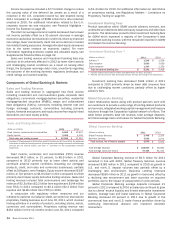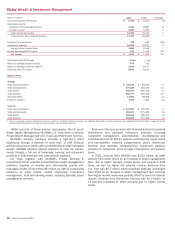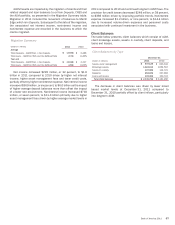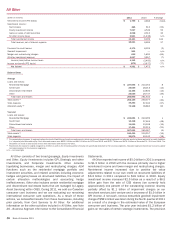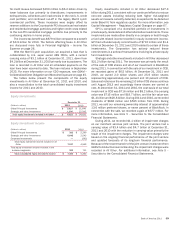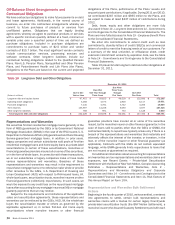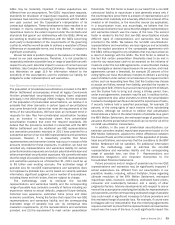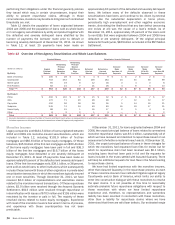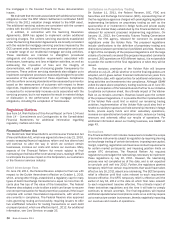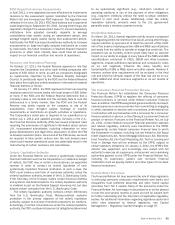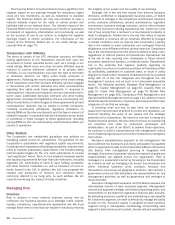Bank of America 2011 Annual Report Download - page 54
Download and view the complete annual report
Please find page 54 of the 2011 Bank of America annual report below. You can navigate through the pages in the report by either clicking on the pages listed below, or by using the keyword search tool below to find specific information within the annual report.52 Bank of America 2011
securitization and other investors increased during 2011 primarily
as a result of the increase in repurchase claims received from
trustees in non-GSE transactions. Generally the volume of
unresolved repurchase claims from the FHA and VA for loans in
GNMA-guaranteed securities is not significant because the
requests are limited in number and are typically resolved quickly.
For additional information concerning FHA-insured loans, see Off-
Balance Sheet Arrangements and Contractual Obligations – Other
Mortgage-related Matters on page 57.
In addition to repurchase claims, we receive notices from
mortgage insurance companies of claim denials, cancellations or
coverage rescission (collectively, MI rescission notices) and the
amount of such notices have remained elevated. When there is
disagreement with the mortgage insurer as to the resolution of a
MI rescission notice, meaningful dialogue and negotiation are
generally necessary between the parties to reach a conclusion on
an individual notice. The level of engagement of the mortgage
insurance companies varies and on-going litigation involving some
of the mortgage insurance companies over individual and bulk
rescissions or claims for rescission limits our ability to engage in
constructive dialogue leading to resolution.
For loans sold to GSEs or private-label securitization trusts
(including those wrapped by the monoline bond insurers), a MI
rescission may give rise to a claim for breach of the applicable
representations and warranties, depending on the governing sale
contracts. In those cases where the governing contracts contain
a MI-related representation and warranty which upon rescission
requires us to repurchase the affected loan or indemnify the
investor for the related loss, we realize the loss without the benefit
of MI. If we are required to repurchase a loan or indemnify the
investor as a result of a different breach of representations and
warranties and there has been a MI rescission, or if we hold the
loan for investment, we realize the loss without the benefit of MI.
In addition, mortgage insurance companies have in some cases
asserted the ability to curtail MI payments, which in these cases
would reduce the MI proceeds available to reduce such loss on
the loan. While a legitimate MI rescission may constitute a valid
basis for repurchase or other remedies under the GSE agreements
and a small number of private-label MBS securitizations, and a MI
rescission notice may result in a repurchase request, we believe
MI rescission notices in and of themselves are not valid repurchase
requests.
At December 31, 2011, we had approximately 90,000 open
MI rescission notices compared to 72,000 at December 31, 2010.
Through December 31, 2011, 26 percent of the MI rescission
notices received have been resolved. Of those resolved, 24 percent
were resolved through our acceptance of the MI rescission, 46
percent were resolved through reinstatement of coverage or
payment of the claim by the mortgage insurance company, and 30
percent were resolved on an aggregate basis through settlement,
policy commutation or similar arrangement. As of December 31,
2011, 74 percent of the MI rescission notices we have received
have not yet been resolved. Of those not yet resolved, 48 percent
are implicated by ongoing litigation where no loan-level review is
currently contemplated (nor required to preserve our legal rights).
In this litigation, the litigating mortgage insurance companies are
also seeking bulk rescission of certain policies, separate and apart
from loan-by-loan denials or rescissions. We are in the process of
reviewing 11 percent of the remaining open MI rescission notices,
and we have reviewed and are contesting the MI rescission with
respect to 89 percent of these remaining open MI rescission
notices. Of the remaining open MI rescission notices, 29 percent
are also the subject of ongoing litigation although, at present,
these MI rescissions are being processed in a manner generally
consistent with those not affected by litigation.
Representations and Warranties Liability
The liability for representations and warranties and corporate
guarantees is included in accrued expenses and other liabilities
on the Consolidated Balance Sheet and the related provision is
included in mortgage banking income (loss). The methodology
used to estimate the liability for representations and warranties
is a function of the representations and warranties given and
considers a variety of factors, which include depending on the
counterparty, actual defaults, estimated future defaults, historical
loss experience, estimated home prices, other economic
conditions, estimated probability that a repurchase claim will be
received, consideration of whether presentation thresholds will be
met, number of payments made by the borrower prior to default
and estimated probability that a loan will be required to be
repurchased as well as other relevant facts and circumstances,
such as bulk settlements and identity of the counterparty or type
of counterparty, as we believe appropriate. In the case of private-
label securitizations, our estimate considers implied repurchase
experience based on the BNY Mellon Settlement, adjusted to
reflect differences between the Covered Trusts and the remainder
of the population of private-label securitizations, and assumes that
the conditions to the BNY Mellon Settlement will be met. The
estimate of the liability for representations and warranties is based
on currently available information, significant judgment and a
number of factors, including those set forth above, that are subject
to change.
At December 31, 2011 and 2010, the liability was $15.9 billion
and $5.4 billion. For 2011, the provision for representations and
warranties and corporate guarantees was $15.6 billion compared
to $6.8 billion in 2010. Of the $15.6 billion provision recorded in
2011, $8.6 billion was attributable to the BNY Mellon Settlement
and $7.0 billion was related to other exposures. The BNY Mellon
Settlement led to the determination that we had sufficient
experience to record a liability related to our exposure on certain
other private-label securitizations. This determination combined
with higher estimated GSE repurchase rates were the primary
drivers of the balance of the provision in 2011. GSE repurchase
rates increased driven by higher than expected claims during 2011,
including claims on loans that defaulted more than 18 months
prior to the repurchase request and on loans where the borrower
has made a significant number of payments (e.g., at least 25
payments), in each case in numbers that were not expected based
on historical claims. Changes to any one of these factors could
significantly impact the estimate of the liability and could have a
material adverse impact on our results of operations for any
particular period.
Estimated Range of Possible Loss
Government-sponsored Enterprises
Our estimated liability as of December 31, 2011 for obligations
under representations and warranties with respect to GSE
exposures is necessarily dependent on, and limited by, our
historical claims experience with the GSEs. It includes our
understanding of our agreements with the GSEs and projections
of future defaults as well as certain other assumptions, and
judgmental factors. Accordingly, future provisions associated with
obligations under representations and warranties made to the




